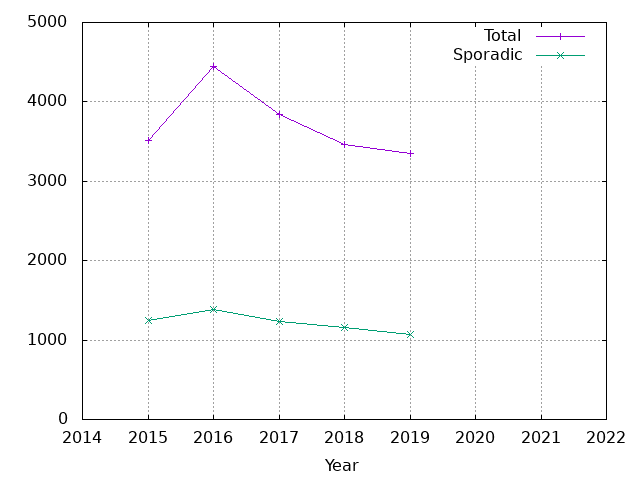Forum Replies Created
-
AuthorPosts
-
 Nick JamesParticipant
Nick JamesParticipantCertainly if there is no confirmation from another camera this would be the most likely cause. I get quite a lot of nocturnal birds/bats on mine illuminated by streetlights but they don’t tend to fly in straight lines.
 Nick JamesParticipant
Nick JamesParticipantThat’s an impressive capture. I’ve seen many examples of dual, and even triple, meteors with the same radiant on my video but never anything quite like this where there are two objects so close. It was clear here last night and my NW cam points in your direction but I didn’t pick anything up at that time.
I’m playing around with RMS using a Pi4 and a cheap IP camera but haven’t had much time to sort out the various problems that have arisen so still rely on the old UFO Capture/902H2 setup.
 Nick JamesParticipant
Nick JamesParticipantNice stamps. That plural is certainly correct in the original latin (where they had strict rules about such things) but I doubt if many Engish speakers would use it now. Reminds me of the Romanes eunt domus skit in the Life of Brian…
 Nick JamesParticipant
Nick JamesParticipantThat would be a sad end for IRAS (famous for the discovery of C/1983 H1 Iras-Araki-Alcock). The predicted time of close approach is 23:39:35 UTC tonight according to LeoLabs.
 Nick JamesParticipant
Nick JamesParticipantGary, yes the sound levels were a bit low although fine if you have a big volume knob on your amplifier it seemed OK. It partly depended on the speaker’s voice and where they were standing. I’ve just had a look at the recordings (which are now on the meetings page BTW) and I can turn it up far enough. I’ll discuss with the IoP whether we can push it up next time.
 Nick JamesParticipant
Nick JamesParticipantAndrew. Many thanks for that observation. This is a good opportunity for visual views as well as imaging.
 Nick JamesParticipant
Nick JamesParticipantIt’s now close enough that I can fit it in the field of my wide-angle imaging system. This is an image from Chelmsford tonight.
 Nick JamesParticipant
Nick JamesParticipantThis is an update of the plot I posted last year. It is the count of meteors from my two cameras since this is the only objective measurement of sky conditions that I have. The sporadic count is probably the one to use since it is not dependent on conditions at the times of shower maxima. This shows a slight deterioration on 2018 and my lowest detection rate so far. Note that 2015 was only a partial year (from June) but most meteor activity is in the last half of the year so it is not easy to scale.

 Nick JamesParticipant
Nick JamesParticipantDavid,
I think these are definitely Burnham. Stefan Beck has suggested dates and times. I’ve updated the page with the latest info although I may have missed some. Independent confirmation would be good.
Nick.
 Nick JamesParticipant
Nick JamesParticipantI’ve updated the article with the results so far. Great stuff.
Nick.
 Nick JamesParticipant
Nick JamesParticipantLars/Paul, That’s a great start with the plate solving. Now we just need to know which comets passed through those points to get the observation date and time. More difficult will be identifying the observers!
I too am surprised that astrometry.net is so good with trailed stars/
 Nick JamesParticipant
Nick JamesParticipantYou’re right, but two mags is quite a lot. I doubt if it would be anywhere near that and would only apply to satellites under control since it is on only one face. Since quite a few are tumbling already it may not be very effective. From our point of view I think we will become more dependent on large numbers of short exposures and clever stacking software. CMOS cameras have come along at just the right time.
 Nick JamesParticipant
Nick JamesParticipantThanks for the feedback. I’ll speak with the AV people at the IoP and will try to improve this for future meetings.
 Nick JamesParticipant
Nick JamesParticipantA recording of the entire event is online at the original URL given at the top of this thread. You can scroll through to find the best bits.
 Nick JamesParticipant
Nick JamesParticipantThanks. I just hope Elon Musk was not watching…
 Nick JamesParticipant
Nick JamesParticipantI heard you mention this during your acceptance yesterday. Amazing stuff.
 Nick JamesParticipant
Nick JamesParticipantThanks all for the feedback. I think it mostly worked well. With the support of the IoP we hope to be able to do this for all our London meetings from now on.
 Nick JamesParticipant
Nick JamesParticipantBefore 2I all of the comets that we know with very slightly hyperbolic orbits acquired the extra velocity through planetary perturbations when they were in the inner Solar System. We would expect comets falling in from the Oort cloud to be in parabolic orbits, i.e. have a velocity of zero at infinity. The largest eccentricity known prior to 2I was 1.057 for C/1980 E1 (Bowell). This large excess velocity (around 3.8 km/s) was acquired from a Jupiter encounter in 1980 December. Comet C/1956 R1 (Arend-Roland) had an exit eccentricity of 1.0002. The pre-perihelion eccentricity was indistinguishable from parabolic. The ultimate end for our comets is to either fall into the Sun or be ejected from our Solar System and become an interstellar comet for some one else.
 Nick JamesParticipant
Nick JamesParticipantAt least when Peter Dunsby discovered Mars (AT 11448 here) he was presented with a nice certificate.
 Nick JamesParticipant
Nick JamesParticipantAs you say, that’s minor planets. Perhaps we should send them a link to Dominic’s site: https://in-the-sky.org/data/planets.php
-
AuthorPosts
